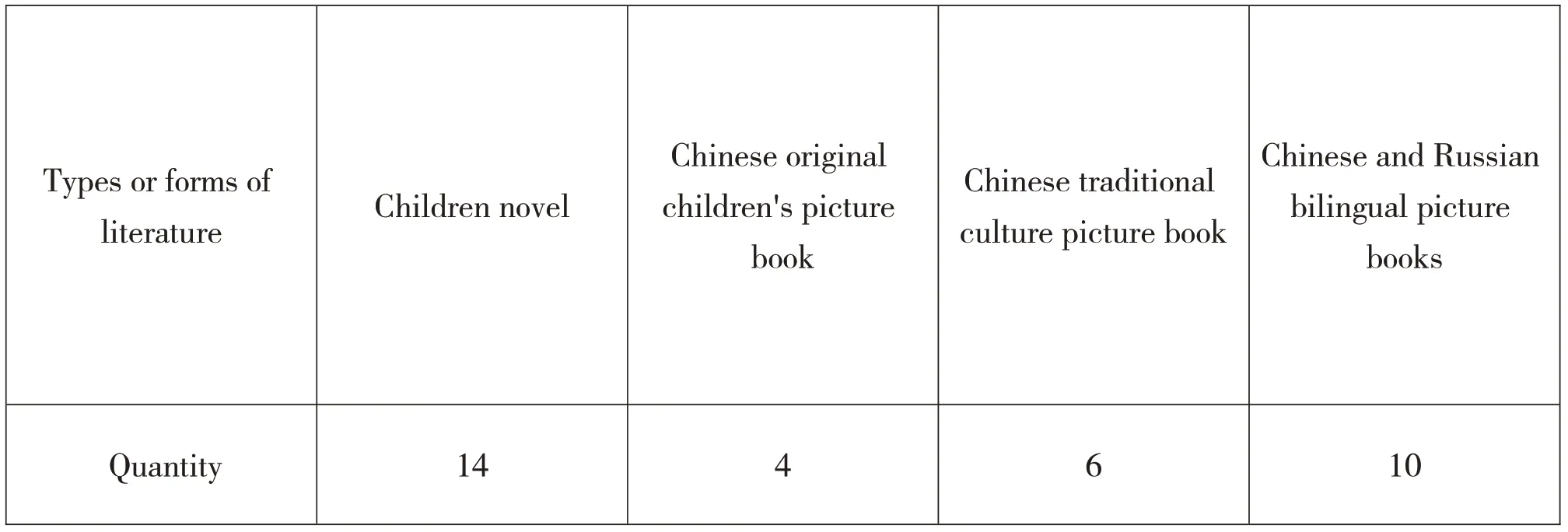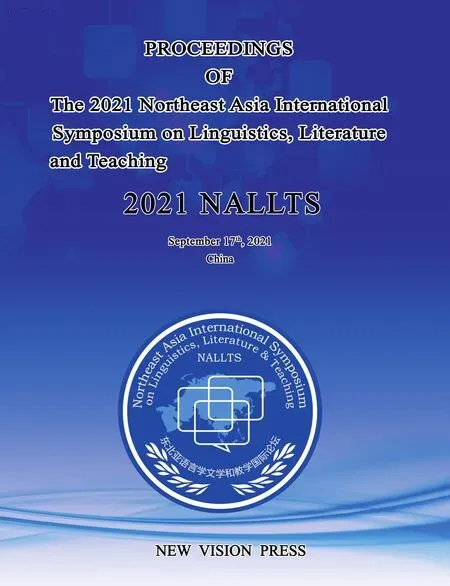Introduction and Translation of Chinese Children's Literature in Russia
Zhang Nan
School of Foreign Languages,Dalian Maritime University,Dalian,China
Email:1533193900@qq.com
Ding Xiaomei
School of Foreign Languages,Dalian Maritime University,Dalian,China
Email:707528940@qq.com
Yang siqi
School of Foreign Languages,Dalian Maritime University,Dalian,China
Email:1808479835@qq.com
[Abstract] Chinese children's literature integrates Chinese characteristic culture and dynamic culture,and has unique social and cultural value,educational care value and aesthetic value.In recent years,with the continuous communication and exchange in the fields of culture and education between China and Russia,the works of Chinese children's literature have attracted more attention in Russia.By searching Russian websites,this paper summarizes the Russian translations of Chinese children's literature works,including the Russian translations of children's novels,children's picture books,children's films and other media,and analyzes the research status of Chinese children's literature in Russia.Exploring the Russian translation of Chinese children's literature can provide reference for the foreign translation of Chinese children's literature,the"going out"of Chinese culture and the good telling of Chinese stories.
[Keywords] Russian translation;Chinese children's literature;Russian translation of picture books
Introduction
Since the beginning of the new century,with the enhancement of China's comprehensive national strength,it has become a national strategy to"transport"Chinese culture,for which purpose,the translation and dissemination of literature is the only way.Because literature deals with every aspect of human spiritual and material life.Recently,the foreign translation of Chinese literature,especially contemporary Chinese literature,has become the focus of the translation and literary circles.Children's literature is an important field of literature research.The translation and dissemination of Chinese children's literature also plays an important role in the strategy of Chinese literature's"going out",but there is still insufficient research on the Russian translation of Chinese children's literature.This paper tries to sort out the publishing situation of Chinese children's literary works in Russia and the research status of Russian scholars on Chinese children's literary works.
Russian scholars'research on the development history of Chinese children's literature
Chinese children's literature contains rich Chinese cultural connotation,which helps foreign children to understand the Chinese nation and learn Chinese.As early as in the 20th century,Russian scholars have studied and analyzed Chinese children's literature.
In 1955,Russian scholar Б.Л.Рифтин first attempted to summarize Chinese children's literature.PublishedAbout modern Chinese children's literature(Рифтин,2017,pp.28-54),analysed the characteristics of modern and contemporary Chinese children's literature,sum up the types of children's books in China.The important position of lu Xun,Ye Shengtao,Zhang Tianyi and other writers in the development history of Chinese children's literature is highlighted.He introduced the Ye Shengtao's two children's literaturescarecrowandthe ancient stone statue of the hero,Zhang tianyi's children's novelsMr.Hua WeiandBees,children's playRong Born at Home,pantomimeThe Big Bad Wolf,and fairy talesThey and We,Luo Wen Ying's StoryandGo to the Movies,which were published in People's Literature Magazine in 1952.In addition,Б.Л.Рифтин also focused on Chinese children's books published after the founding of new China.It mentioned some popular science works like Gao Shiqi's poetic novelOur Mother-- Earth,Four Great Inventions of Ancient China,Scientists of Ancient China,Famous Artists of Ancient China,Poets of Ancient Chinaand other children's books,that introduce ancient Chinese culture and Chinese science and technology.At the end of the paper,the status of picture books in modern Chinese children's literature is also highlighted,and the Chinese children's picture books,such asJimao LetterandLittle Worker,are introduced.The article also introduced the Chinese children's literature magazines and newspapers,such asLittle Friends,Middle School students,Youth Daily,The Motherland youth Daily,China Children's Newspaperand so on.Finally,the Chinese children's literature,which was born under the socialist background,inherits the valuable experience of Soviet children's literature and the tradition of national literature,and has Chinese national characteristics.
Russian scholar Ю.С.Осипов in 1958 published Chinese fiction for children (based on the materials of recent years(Осипов,2017,pp.9-27),which explained the general characteristics of Chinese children's literature from 1954 to 1956,and proposes that Chinese children's books during this period mainly provide ideological and political education to children,involving themes of heroism,revolution and war,etc.Most of the related themes of Chinese traditional culture are folk fairy tales.Children's literature of this period is mostly illustrated in black and white.
In 2013,Russian scholar Р.В.Замилова explained the influence of Chinese children's literature on Russia in his articleCOMPARISON of Chinese and Russian Children's Literature in the First Half of the 20th Century(Замилова,2013).She mentioned that in the 16th century Chinese children's books began to gain attention in Russia.In the 20th century,Chinese children's literature works occupied a special position in Russia.From 1949 to 1965,children's literature by Chinese writers was widely distributed in the Soviet Union.For example,Lu Xun's short storiesHometownandSocial Dramawere translated into Russian for Soviet children to read.There are also Gao Yubao'sI WanttoLearn,Zhu Baohua'sA Bao's New Clothes,Liu Baiyu'sYoung Pioneers,Zhang Jinxia's poemI am not Afraid,Yuan Zhangjing's collection of poemsGolden Shells,and Huashan's short storyJimao Letter.In addition,there are also children's books published in the form of anthologies,such asChinese Folktales,Chinese Stories,Zhong(Chinese Fairy Tales),Children across the Sea,The Magic Brush,Dragon's Eyes,Yellow Crane and Sun Mountain,etc.,all of which have been published and reprinted in Russian.
In 2016 Р.В.Замилова on the basis of Ю.С.Осипов's articles,published theNEW WAVE in the children's literature of China in the 80s of the twentieth century(Замилова,2019,pp.1626-1635),In this paper,the development of Chinese children's literature from 1978 to 1989 was analyzed in order.The author took the children's literature works of Wang Quangen,Wu Qinan,Zhou Zuoren and Tang Rui as examples to analyze the characteristics of Chinese children's literary works in this period.It mentioned the early 20th centuryThree Character Classic,Thousand Character Text,100 Family Namesand Chinese children's primer books adapted from Confucian classics.Introduced MeiZiHanYour highland,Liu JianpingI want my burin,and other Chinese children's literature.
Introduction of Chinese children's literature by Russian scholars
Russian scholar Е.Ч.Сергеевна on May 4th youth day in 2016,published an articleChildren's literature in China,the article took pains to mention,such as Mo Yan writers view of children's literature,introduced the relevant Chinese children's literature,including children's books,Children's picture book mysterious China,Luo Ying'sChild Prodigy and The Story of Leaves,King of fairy talesZheng Yuanjie's collection of fairy talesPipilu;City of Fantasyby Guo Jingming,Yang Hongying'sGirl diary,Boy Diary,Naughty Bag Ma Xiaotiao and Campus Novel,and Cao Wenxuan'sBronzeandSunflowerandTinkling,Tinkling,Tinkling,as well as popular pop-up books for children.
Russian scholar А.А.Родионов publishedAbout the translation and publication in Russian of the latest Chinese prose in 2009-2018(Родионов,2019,pp.398-430).In this article he summarized the introduction and translation of Chinese literature in Russia,including Children's literature by Cao Wenxuan.The article concluded that the number of Russian translations of Chinese literary works reached a peak between 2009 and 2010.The reasons for the low Russian translation of Chinese literary works are the increase in the number of Chinese literary works and the scarcity of translators.
Russian scholar Р.Н.Николаевна published articlesThe system of images of animals in Chinese folk tales,analyzed animal image system in the fairy tale in Chinesehannationality folk.A typology method,textual analysis and hermeneutic methods are used to compare the images,meanings and functions of animals in Chinese folk fairy tales of animal types,magical types and everyday types.Using systematic analysis method,ethnology analysis method,context analysis method and semantics analysis method to analyze the animal images inhanfolk fairy tales from the aspects of subject matter,style,language and national characteristics,so as to study the cognitive characteristics of Chinese folk fairy tales and Chinese nation.
In 2020,Russian scholar О.Т.Александровна and У.А.Викторович in their articleCriteria for the linguodidactic selection of book editions of translated Chinese folk tales in Russian(Острикова &Упоров,2020,pp.131-147)list more than 120 Chinese folk tales and their Russian translations,and summarized the number of works in the collection and the titles of the collection,in order to provide information for Russians to learn Chinese.
Russian scholar С.В.Новаш publishedThe originality of Chinese children's literature(Новаш,2018,pp.131-147),the article analyzed the characteristics of Chinese children's literature thestraw house,including the character image,natural scenery.Through the analysis of historical background and national characteristics,it concluded that Cao Wenxuan's works have educational significance,aesthetic function,full of heroism,and can arouse readers'empathy for the hero.Firstly,the development history of Chinese children's literature is sorted out,and the authors and works of Chinese children's literature are introduced in stages,includingThe Scarecrowby Ye Shengtao,Little Readersby Bing Xin andLittle Orangeby Bing Xin during the May Fourth Movement period.Besides,children's literature writers Zheng Yuanjie,Cao Wenxuan,Yang Hongying,Shen Shixi,Zhang Tianyi,etc.Cao Wenxuan'sGrass House,Guo Jingming'sBefore Summer Solstice,Qin Wenjun'sHappy Girl,Mei Zihan'sMy Story.It mainly mentions the popular writer Cao Wenxuan's children's literature worksGrass House,Bronze and Sunflower,Fine rice,YellowGlazein the first book of the King,Red Gauze lampin the second book of the King,and so on.
Chinese scholars'response to the Russian translation of Chinese children'sliterature
In 2020,Chinese scholar Guan Xiujuan discussed the Russian translation and dissemination of Chinese children's literature,and took author Cao Wenxuan's works as an example to analyze the Russian translation and publication of his works.Some suggestions on the Russian translation and dissemination of Chinese children's literature are given:increase the number of Russian translation of relevant works and solve cultural differences to make readers understand and accept them.In this paper,multimedia,multi-modal and multi-channel translation is advocated.Various cultural promotion measures combining online and offline,multi-modal and three-dimensional are adopted to help Chinese children's literature win more readers.With the help of literary works,it has launched a series of products such as animation,film,radio drama,comic book,stickers and dolls.Strengthen discussion and accept the criticism of readers,so as to enhance the attention of Russian readers to the works of Chinese writers,and broaden the Russian translation of Chinese children's literature(Guan,2020).
By searching Russian websites,the Russian translations of Chinese children's literature works are summarized as follows,see Table 1:

Table 1 :the Russian translations of Chinese children's literature works
By searching Russian websites "китайские мультфильмы для детей",The number of Russian translations of Chinese children's films and TV shows is obtained as follows,see Table 2:

Table 2 :Russian translations of Chinese children's films and TV shows
Conclusion
To sum up,most of the researches on Chinese children's literature by Russian scholars focus on the review and summary of its development history,and are mostly limited to the Chinese children's literature in the last century.Few Russian scholars have studied specific Chinese children's literary works.Only some of them have analyzed Chinese folk fairy tales to explore the cognitive characteristics of the Chinese nation,and some have analyzed the awardwinning works of Cao Wenxuan to explore their literary characteristics and value.At present,no scholar has systematically sorted out Chinese children's literature works.Based on this,this paper attempts to sort out and summarize the Russian translations of popular Chinese children's literature works.By searching Russian websites,it is found out that Chinese children's literary works in genres such as novels,picture books and movies have been published and distributed in Russia.Among them,there are many Russian translations of Children's literary works by Cao Wenxuan,and a few Russian translations of children's novels by Zhang Tianyi and Shen Shixi.Most Of the Russian translations of Chinese children's picture books are those from Taiwan.In recent years,the Russian translation of Chinese traditional culture picture books,Chinese and Russian bilingual picture books and other works have been increasing.Since the beginning of the new century,more than 10 Chinese animation works have been shown in Russia every year.In a word,Chinese children's literary works have been adapted or translated into novels,slide shows,audio books,picture books,cartoons and other forms in Russia,and are deeply loved by Russian readers and audiences.
ACKNOWLEDGEMENTS
This paper is part of the project of Nation Social Science Foudation of China,Research on A comparative study on ecological thoughts of Chinese and Russian children's literature works under the Concept of "Community" in the New Era(grant#L20BWW010).
AUTHORS'RESPONSIBILITIES©RIGHT
Copyright ownership belongs to authors,shall not be reproduced,copied,or used in other ways without permission.
 Proceedings of Northeast Asia International Symposium on Linguistics,Literature and Teaching2021年0期
Proceedings of Northeast Asia International Symposium on Linguistics,Literature and Teaching2021年0期
- Proceedings of Northeast Asia International Symposium on Linguistics,Literature and Teaching的其它文章
- Exploring C-E Simultaneous Interpreting Skills from the Perspective of Adaptation Theory
- Make a Better Story of China:Cross-lingual Presentation of the Subtopic"De"(德)of Lun Yü
- Comparative Study of Four English Versions of Ye Yu Ji Bei from Perspective of Eco-Translatology
- A Study on L2 Learners'Computer-mediated Interaction in SLA Writing
- Effect of Grammatical Class:What Role does a Chinese Background Play in Bilinguals?
- Influence of Teachers'L1 Translation Use on Chinese Intermediate EFL Learners'L2 Vocabulary Learning
